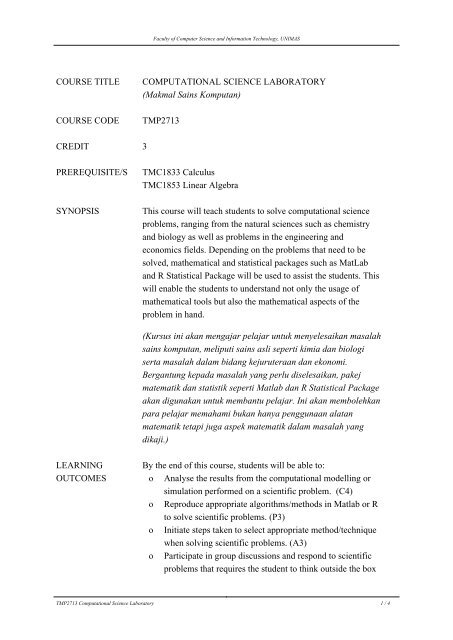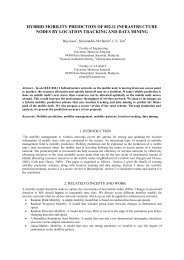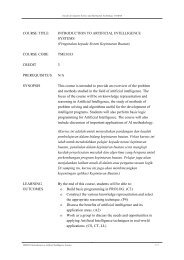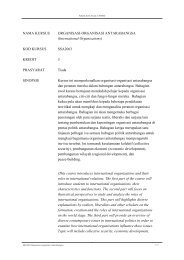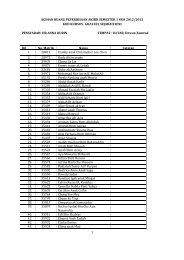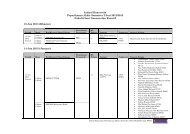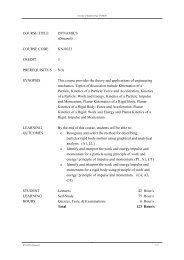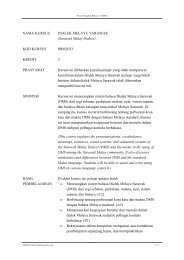COURSE TITLE COMPUTATIONAL SCIENCE LABORATORY ...
COURSE TITLE COMPUTATIONAL SCIENCE LABORATORY ...
COURSE TITLE COMPUTATIONAL SCIENCE LABORATORY ...
Create successful ePaper yourself
Turn your PDF publications into a flip-book with our unique Google optimized e-Paper software.
Faculty of Computer Science and Information Technology, UNIMAS<br />
<strong>COURSE</strong> <strong>TITLE</strong><br />
<strong>COURSE</strong> CODE<br />
<strong>COMPUTATIONAL</strong> <strong>SCIENCE</strong> <strong>LABORATORY</strong><br />
(Makmal Sains Komputan)<br />
TMP2713<br />
CREDIT 3<br />
PREREQUISITE/S<br />
SYNOPSIS<br />
TMC1833 Calculus<br />
TMC1853 Linear Algebra<br />
This course will teach students to solve computational science<br />
problems, ranging from the natural sciences such as chemistry<br />
and biology as well as problems in the engineering and<br />
economics fields. Depending on the problems that need to be<br />
solved, mathematical and statistical packages such as MatLab<br />
and R Statistical Package will be used to assist the students. This<br />
will enable the students to understand not only the usage of<br />
mathematical tools but also the mathematical aspects of the<br />
problem in hand.<br />
(Kursus ini akan mengajar pelajar untuk menyelesaikan masalah<br />
sains komputan, meliputi sains asli seperti kimia dan biologi<br />
serta masalah dalam bidang kejuruteraan dan ekonomi.<br />
Bergantung kepada masalah yang perlu diselesaikan, pakej<br />
matematik dan statistik seperti Matlab dan R Statistical Package<br />
akan digunakan untuk membantu pelajar. Ini akan membolehkan<br />
para pelajar memahami bukan hanya penggunaan alatan<br />
matematik tetapi juga aspek matematik dalam masalah yang<br />
dikaji.)<br />
LEARNING<br />
OUTCOMES<br />
By the end of this course, students will be able to:<br />
o Analyse the results from the computational modelling or<br />
simulation performed on a scientific problem. (C4)<br />
o Reproduce appropriate algorithms/methods in Matlab or R<br />
to solve scientific problems. (P3)<br />
o Initiate steps taken to select appropriate method/technique<br />
when solving scientific problems. (A3)<br />
o Participate in group discussions and respond to scientific<br />
problems that requires the student to think outside the box<br />
TMP2713 Computational Science Laboratory 1 / 4
Faculty of Computer Science and Information Technology, UNIMAS<br />
and critically analyse different methods that can be used to<br />
computationally model and simulate these problems. (CS,<br />
CT, TS, LL)<br />
STUDENT<br />
LEARNING<br />
HOURS<br />
Lectures<br />
Laboratories/Practical<br />
Self-Study<br />
Quizzes, Tests, & Examinations<br />
Total<br />
28 Hour/s<br />
14 Hour/s<br />
87 Hour/s<br />
6 Hour/s<br />
135 Hour/s<br />
LEARNING<br />
UNITS<br />
Supervised<br />
Learning Hours<br />
1. Introduction to Computational Science<br />
Mathematics<br />
Chemistry<br />
Biology<br />
Physics<br />
2<br />
2. Computational tools<br />
2<br />
- MatLab<br />
- R Statistical Package<br />
3. Errors and Uncertainties in Computations<br />
2<br />
- Type of errors<br />
- Experimental Error Investigation<br />
4. Visualization<br />
- Data visualization<br />
- Type of graph<br />
- Graph plotting<br />
2<br />
5. Computational mathematics<br />
2<br />
- Modelling<br />
- Simulation<br />
6. Computational mathematics<br />
2<br />
7. Computational Chemistry<br />
2<br />
- Drug Discovery<br />
- Compound Selection (Fuzzy Clustering)<br />
8. Computational Chemistry<br />
2<br />
- Predicting molecular geometry<br />
TMP2713 Computational Science Laboratory 2 / 4
Faculty of Computer Science and Information Technology, UNIMAS<br />
- Molecular vibrations<br />
9. Computational Biology<br />
2<br />
- Introduction to Molecular Biology (Genes )<br />
10. Computational Biology<br />
2<br />
- Information in Molecular Biology<br />
11. Computational Algorithms in Biology<br />
2<br />
- Dynamic Programming Matrices in Sequence<br />
Alignment<br />
12. Computational Physics<br />
2<br />
- An Aircraft Survivability Analysis<br />
- Simulation Model for Aircraft Vulnerability<br />
13. Computational Physics<br />
2<br />
- Modeling of Fluid Flow<br />
14. Fractals and Statistical Growth<br />
2<br />
- The Sierpinski Gasket<br />
- Stock/Finance Estimation<br />
ASSESSMENT Assignment 01<br />
10 %<br />
Assignment 02<br />
15 %<br />
Lab Pratical<br />
10 %<br />
Group Project<br />
20 %<br />
Mid Sem<br />
15 %<br />
Final Exam<br />
30 %<br />
Total<br />
100 %<br />
REFERENCES 1. Introduction to Computational Science: Modeling and<br />
Simulation for the Sciences, Shiflet, A.B., , G.W. Princeton<br />
University Press, 2006<br />
2. Introduction to Bioinformatics Algorithms, Jones, N. , P.,<br />
MIT Press, 2004<br />
3. Introduction to Computational Biology: An Evolutionary<br />
Approach, Haubold, B. , T., Birkhauser Basel Pub., 2007<br />
4. Introduction to Computational Chemistry, Frank Jensen,<br />
2nd Ed. Wiley Pub., 2006<br />
TMP2713 Computational Science Laboratory 3 / 4
Faculty of Computer Science and Information Technology, UNIMAS<br />
Last updated: July 28, 2011, Thu, 1:08 PM<br />
TMP2713 Computational Science Laboratory 4 / 4


